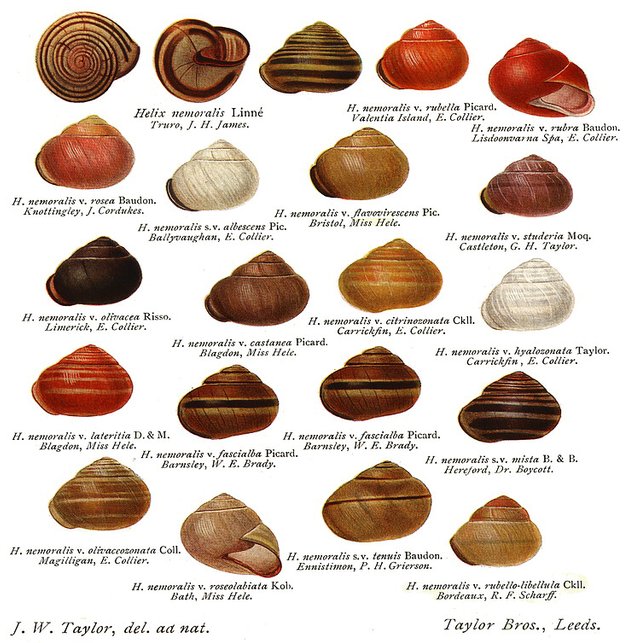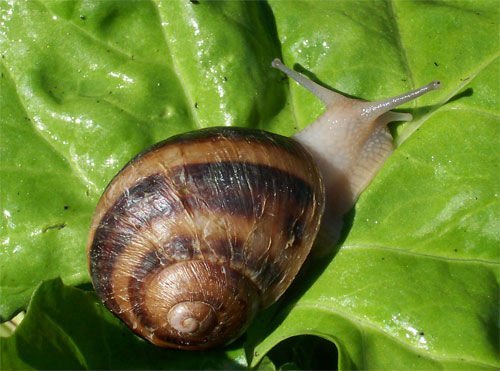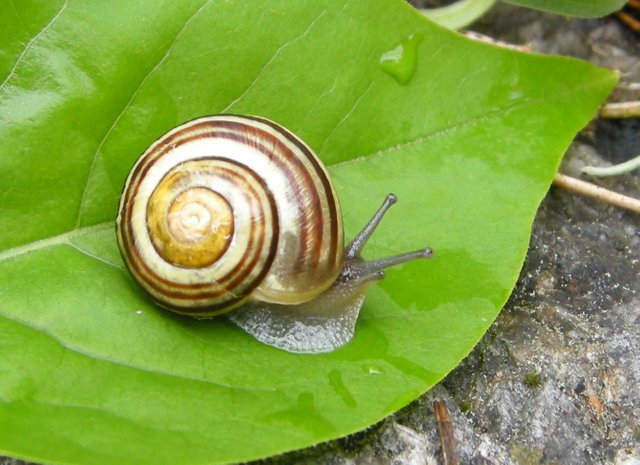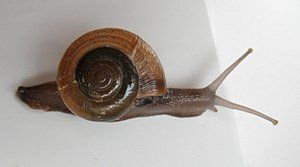
image source
Palatable land snails go in estimate from around one millimeter long to the goliath African snails, which every so often grow up to 312 mm (12 1⁄4 in) long. "Escargot" most normally alludes to either Helix aspersa or to Helix pomatia, albeit different assortments of snails are eaten.

Achatina fulica
It is a mammoth African snail, is cut and canned and go off on a few buyers as escargot. Terms, for example, "plant snail" or "normal dark colored garden snail" are somewhat unimportant since they allude to such huge numbers of sorts of snails, yet they here and there mean H. aspersa.

Helix aspersa
The helix aspersa is otherwise called the French "petit gris," "little dim snail," the "escargot chagrine," or "la zigrinata." The shell of a develop grown-up has four to five whorls and measures 30 to 45 mm over. It is local to the shores of the Mediterranean and up the shoreline of Spain and France. It is found on numerous British Isles, where the Romans presented it in the first century AD (Some references say it dates to the Early Bronze Age.) In the mid nineteenth century the French brought it into California, where it has turned into a genuine bug.
These snails are presently basic all through the U.S. It was brought into a few Eastern and Gulf states even before 1850 and, later brought into different nations, for example, Australia, South Africa, New Zealand, Mexico, and Argentina. H. aspersa has a life expectancy of 2 to 5 years. This species is more versatile to various atmospheres and conditions than numerous snails, and is found in woods, fields, sand rises, and gardens. This flexibility not just expands H. aspersa's range, yet it additionally makes cultivating H. aspersa less demanding and less dangerous.

Helix pomatia
The measures around 45 mm over the shell. It likewise is known as the "Roman snail," "apple snail," "lunar," "la vignaiola," the German "Weinbergschnecke," the French "escargot de Bourgogne" or "Burgundy snail," or "gros blanc." Native over a substantial piece of Europe, it lives in lush mountains and valleys up to 2,000 meters (6,600 feet) height and in vineyards and patio nurseries.
The Romans may have brought it into Britain. Settlers brought it into the U.S. in Michigan and Wisconsin. Numerous favor H. pomatia to H. aspersa for its flavor and its bigger size, as the "escargot second to none."

Otala lactea
This is now and then called the "vineyard snail," "drain snail," or "Spanish snail." The shell is white with rosy dark colored winding groups and measures around 26 to 35 mm in width.
Iberus alonensis, the Spanish "vaqueta" or "serrana", measures around 30 mm over the shell.

Cepaea nemoralis
Cepaea nemoralis, the "woods snail," or the Spanish "vaqueta", measures around 25 mm over the shell. It possesses Central Europe and was brought into, and is currently naturalized in numerous U.S. states, from Massachusetts to California, and from Tennessee to Canada. Its territory extends generally from woods to ridges. It for the most part eats dead plant material, yet it loves brambles and buttercups and will eat dead worms and dead snails.

Cepaea hortensis
The "white-lipped snail", measures around 20 mm over the shell which regularly has unmistakable dull stripes. It is local to focal and northern Europe. This species was brought into Maine, Massachusetts, and New Hampshire in pilgrim times, however it never wound up set up in these states. Its environment changes however C. hortensis is found in colder and wetter spots than C. nemoralis. Their littler size and a few people's supposition that they don't taste as great make C. hortensis and C. nemoralis less mainstream than the bigger European land snails.

Otala punctata
This is also called "vaqueta" in a few sections of Spain, measures around 35 mm over the shell.

Eobania vermiculata
The "vinyala," "mongeta," or "xona", measures around 25 mm. It is found in Mediterranean nations and was brought into Louisiana and Texas.

Helix lucorum
This is now and again called "escargo turc," measures around 45 mm over the shell. It is found in focal Italy and from Yugoslavia through the Crimea to Turkey and around the Black Sea.
Helix adanensis originates from around Turkey.
Helix aperta
The measures around 25 mm. Its meat is very prized. It is local to France, Italy, and other Mediterranean nations and has turned out to be built up in California and Louisiana. Some of the time known as the "tunneling snail," it is found over the ground just amid stormy climate. In sweltering, dry climate, it tunnels three to six crawls into the ground and winds up lethargic until the point when rain diminishes the dirt.

Theba pisana
Likewise called the "joined snail"or the "cargol avellanenc", measures around 20 mm and lives on dry, uncovered destinations, more often than not close to the ocean. Local to Sicily, it has been spread to a few European nations, including England.
This snail is a genuine garden bother and is the "white snail" that California once killed by utilizing flamethrowers to consume off entire territories. In extensive numbers, up to 3,000 snails for each tree, it can attack a garden in 24 hours and a citrus or other product in a few evenings.
Sphincterochila candidissima or Leucochroa candidisima, the "cargol mongeta," or "cargol jueu" measures around 20 mm.

Achatina fulica
Achatina fulica and other Achatina species, goliath African snails. They can grow up to 326 mm (1 ft ¾ in) long. Their local range is south of the Sahara in East Africa. This snail was intentionally brought into India in 1847.
There was an unsuccessful endeavor to set up it in Japan in 1925. It has been intentionally and incidentally transported to other Pacific areas and was coincidentally discharged in California after World War II, in Hawaii, and later in North Miami Florida in the 1970s. In numerous spots, it is a genuine rural bug that causes extensive yield harm.
Additionally, because of its huge size, its ooze and fecal material make an annoyance as does the scent that happens when something like toxic substance lure makes extensive numbers bite the dust. The U.S. has attempted to annihilate Achatina. The U.S. Branch of Agriculture (USDA) has restricted the importation and ownership of live Giant African snails. However, they are as yet looked for after as pets because of the energetic "tiger stripes" on their shells.
Reference
- Michigan and Wisconsin. (October 1934). "escargot de Bourgogne" (PDF). New York
.jpeg)

.jpeg)
.jpeg)
.jpeg)

.jpeg)

.jpeg)
.jpeg)
.jpeg)
.jpeg)
Amazing publication @abiye, thanks for sharing.
Resteem
(to be a part of this community; ensure to always use #farms and #steemchurch for agricultural related post)
SteemChurch Farm ( @FARMS)
Downvoting a post can decrease pending rewards and make it less visible. Common reasons:
Submit
Thanks brother @abiye for such an insight in types and choice of snails. Thanks very much.
Downvoting a post can decrease pending rewards and make it less visible. Common reasons:
Submit
the Achatina fulica Is the biggest snail ever known and of course like you rightly pointed out is the biggest found in Africa
I never got to find out about the other kinds of snail, maybe it's because I'm in Africa, I may never even had considered them really edible, thanks for really educating @Abiye, it's really good to know.
Downvoting a post can decrease pending rewards and make it less visible. Common reasons:
Submit
Great educative post about snail farming. In addition, snail can be reared any where because it requires little space of land. We should be careful of with our crops leafs because they can destroy them all by eating them.
Downvoting a post can decrease pending rewards and make it less visible. Common reasons:
Submit
I want to add also, that the commercialization of the snails in the consumer countries includes the sale live, frozen, canned and also already cooked and seasoned, ready for consumption. There are also by-products of the snail, such as caviar (eggs cured in brine), snail pâté and snail slime used in the pharmaceutical and cosmetic industry. Thanks brother abiye for sharing.
Downvoting a post can decrease pending rewards and make it less visible. Common reasons:
Submit
Impressive..this is a gold mine we have been ignoring because its not 'crude oil' ..kudos bro..and thanks for sharing
Downvoting a post can decrease pending rewards and make it less visible. Common reasons:
Submit
Interesting. How many edible land snails are they? Are you listing all of them?
Downvoting a post can decrease pending rewards and make it less visible. Common reasons:
Submit
I do not know that there were so many edible snail species. Thank you
Downvoting a post can decrease pending rewards and make it less visible. Common reasons:
Submit
Dear @abiye, I congratulate you for your publication, very interesting, I did not know the gastronomic importance of the snail, in Europe, because in the central zone of Latin America, and here in Venezuela, the sea snail is usually consumed, thanks for your information , for my part, continue supporting with my publications this great project of STEEMCHURCH FARMS (@FARMS), greetings brother.
Downvoting a post can decrease pending rewards and make it less visible. Common reasons:
Submit
I did not know there was so much variety of snails, Some eat but I personally could not eat one ... hahaha ... As for the African snails, here in Venezuela they are seen as carriers of many diseases, so see an African snail close, uncomfortable and scary.
Downvoting a post can decrease pending rewards and make it less visible. Common reasons:
Submit